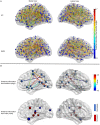Information Flow Pattern in Early Mild Cognitive Impairment Patients
- PMID: 34858306
- PMCID: PMC8631864
- DOI: 10.3389/fneur.2021.706631
Information Flow Pattern in Early Mild Cognitive Impairment Patients
Abstract
Purpose: To investigate the brain information flow pattern in patients with early mild cognitive impairment (EMCI) and explore its potential ability of differentiation and prediction for EMCI. Methods: In this study, 49 patients with EMCI and 40 age- and sex-matched healthy controls (HCs) with available resting-state functional MRI images and neurological measures [including the neuropsychological evaluation and cerebrospinal fluid (CSF) biomarkers] were included from the Alzheimer's Disease Neuroimaging Initiative. Functional MRI measures including preferred information flow direction between brain regions and preferred information flow index of each brain region parcellated by the Atlas of Intrinsic Connectivity of Homotopic Areas (AICHA) were calculated by using non-parametric multiplicative regression-Granger causality analysis (NPMR-GCA). Edge- and node-wise Student's t-test was conducted for between-group comparison. Support vector classification was performed to differentiate EMCI from HC. The least absolute shrinkage and selection operator (lasso) regression were used to evaluate the predictive ability of information flow measures for the neurological state. Results: Compared to HC, disturbed preferred information flow directions between brain regions involving default mode network (DMN), executive control network (ECN), somatomotor network (SMN), and visual network (VN) were observed in patients with EMCI. An altered preferred information flow index in several brain regions (including the thalamus, posterior cingulate, and precentral gyrus) was also observed. Classification accuracy of 80% for differentiating patients with EMCI from HC was achieved by using the preferred information flow directions. The preferred information flow directions have a good ability to predict memory and executive function, level of amyloid β, tau protein, and phosphorylated tau protein with the high Pearson's correlation coefficients (r > 0.7) between predictive and actual neurological measures. Conclusion: Patients with EMCI were presented with a disturbed brain information flow pattern, which could help clinicians to identify patients with EMCI and assess their neurological state.
Keywords: early mild cognitive impairment; information flow; resting state functional MRI; support vector classification; support vector regression.
Copyright © 2021 He, Ding, Jiang, Wang, Luo, Wang and Alzheimer's Disease Neuroimaging Initiative.
Conflict of interest statement
The authors declare that the research was conducted in the absence of any commercial or financial relationships that could be construed as a potential conflict of interest.
Figures



Similar articles
-
Altered Functional Connectivity of the Basal Nucleus of Meynert in Subjective Cognitive Impairment, Early Mild Cognitive Impairment, and Late Mild Cognitive Impairment.Front Aging Neurosci. 2021 Jun 25;13:671351. doi: 10.3389/fnagi.2021.671351. eCollection 2021. Front Aging Neurosci. 2021. PMID: 34248603 Free PMC article.
-
Changes in thalamic connectivity in the early and late stages of amnestic mild cognitive impairment: a resting-state functional magnetic resonance study from ADNI.PLoS One. 2015 Feb 13;10(2):e0115573. doi: 10.1371/journal.pone.0115573. eCollection 2015. PLoS One. 2015. PMID: 25679386 Free PMC article.
-
High-sensitivity neuroimaging biomarkers for the identification of amnestic mild cognitive impairment based on resting-state fMRI and a triple network model.Brain Imaging Behav. 2019 Feb;13(1):1-14. doi: 10.1007/s11682-017-9727-6. Brain Imaging Behav. 2019. PMID: 28466439
-
Classification of early-MCI patients from healthy controls using evolutionary optimization of graph measures of resting-state fMRI, for the Alzheimer's disease neuroimaging initiative.PLoS One. 2022 Jun 21;17(6):e0267608. doi: 10.1371/journal.pone.0267608. eCollection 2022. PLoS One. 2022. PMID: 35727837 Free PMC article.
-
Exploring brain effective connectivity of early MCI with GRU_GC model on resting-state fMRI.Appl Neuropsychol Adult. 2024 Mar 21:1-12. doi: 10.1080/23279095.2024.2330100. Online ahead of print. Appl Neuropsychol Adult. 2024. PMID: 38513360 Review.
References
LinkOut - more resources
Full Text Sources

